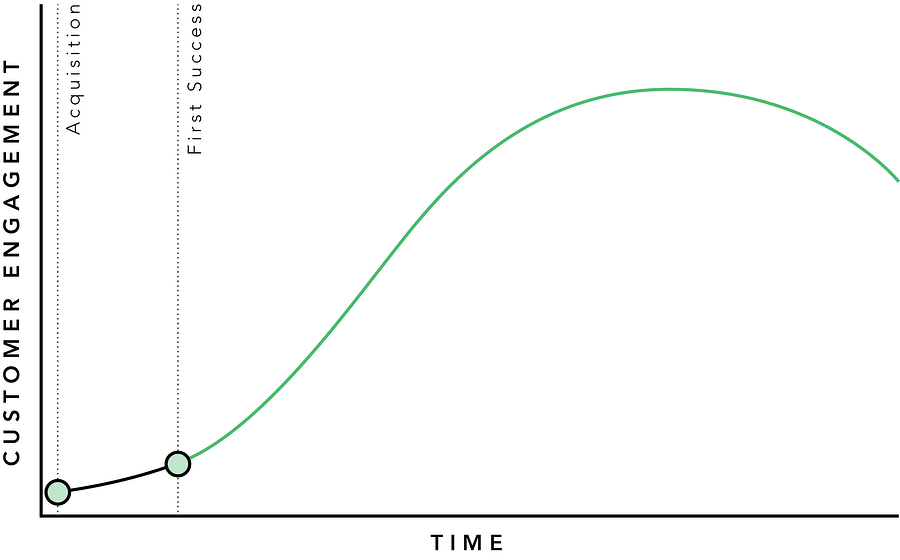Once a new user has made the choice to purchase your software solution, their focus shifts to solving the problems they’ve been facing. As they get to know a product, the relationship between the company and customer is truly defined and developed. It’s time for both you and your product to prove its worth or risk losing them before you even hit the ground.
And so, onboarding becomes an extremely critical time in the lifecycle of a customer.
Some organizations prefer to handle their onboarding through purely self-service routes—and there are certainly plenty of software products in the market where this is appropriate, where a customer never needs to interact with anyone as they get up and running. Customers receive a trial and, if they can see how it will help them, they make a purchase and move into a self-paced onboarding process. This approach suits products with a lower level of complexity.
However, when a product needs more directed learning, the onboarding period becomes a critical time for new customers. As they are getting to know a piece of software, there is also plenty of opportunity for early engagement.
The importance of influencing product adoption
ChurnZero writes that “40-60% of software users only open an app once and then never log in again. The reality is that this initial moment of conversion is not really where the ‘win’ of a customer happens.”
For many software organizations, understanding and measuring product adoption and customer wins is crucial. Initial engagement with a product—often within the first 24 hours—has a significant downstream effect on conversion and longevity. Simply put, the faster customers become comfortable using the product, the longer you can expect them to remain as customers.
There are two important milestones in customer onboarding that are key pivot points towards greater product adoption and customer engagement:
- When customers make their purchase of a product.
- When new customers achieve their first success with a product.
First, when someone buys a new product, whether professionally or personally, there’s a great level of excitement about their opportunities. They begin to imagine what will be possible and how the product will change their current experience. Whether it’s a new car or a piece of software, envisioning the potential can be a strong driver of emotional investment after purchase—and increase their willingness to invest the time needed for learning.
Momentum is very strong at this point, as a customer who has made it through the sales process is ready to begin exploring. Don’t leave them to search for what they’ll need in order to be successful. Instead, strike while the iron’s hot. Make sure that strong welcome messaging and communication puts all the useful resources directly in front of them.
This leads, naturally, to the second critical moment: experiencing their first success with the new product, also known as time-to-value. When they arrive at their first win, the initial promise of the product is realized—and begin to justify their investment. As a result, an emotional bond grows between the customer, the product, and your company. The sooner your customer’s hopes and expectations are met with a win, the more invested they become.
To help move this along, work to identify the most powerful early wins your product offers and make sure customers achieve them.
Onboarding can also help build long-lasting customers by teaching them about stickier, more complex features sooner. According to Gainsight, “Customers using more complex, more valuable features are far less likely to churn, and far more likely to buy additional products from you when they come along.” Use product metrics, surveys, and other methods of gathering information to identify features that help users the most.
When you have a sense of which features are invaluable when they’re used effectively, prioritize messaging and training around them. Customers who understand how to use more complex features sooner will, logically, also see a greater ROI sooner. If you can accomplish this as part of onboarding, you will keep them around longer.
Making onboarding stronger through online learning and training
Creating learning pathways around a topic area for individuals to step through can be very effective. For instance, a defined learning pathway for learners can give them the content they need at the right times as they learn your product. They may do some reading and step through task-based exercises before taking an assessment of the skills they’ve gained. Then, they could choose from a variety of self-paced experiences based on their interests or particular challenges.
You may also offer a path towards certification as a way of encouraging the time investment to build expertise. The goal here should be to remove the guesswork for learners and recommend the best ways to effectively learn about a particular product, use case, or topic.
Sometimes, new members may join a team and need to quickly get up to speed on a key piece of software. Learning paths and training programs can offer the most effective way to onboard them into the organization. They help these learners make their way from point A to point B, derive value quickly, and understand the things that will make them effective in their role. Learning paths are very popular at different stages for different roles, which could mean distinct learning paths for the business administrator, the design team, and the content creation team.
On-demand learning content can also assist the onboarding of busy users who just want an answer quickly. For them, a knowledge base can offer the short answer to common sticking points that affect new users. Consider offering another layer of on-demand programming and content, though, that focuses on specific use cases and user goals. With online learning experiences, you give users the next level of understanding they need to move their product experience forward—and help to make the product sticky.
Effective online learning during onboarding
The key to effective learning for software is that users are able to find and access the learning they need within the context of your product. Aim to help users become successful in a way that doesn’t feel like an interruption of their tasks. An appropriate presentation of useful information and suggested learning focuses on assisting these users.
Offering help and encouragement where they’ll need it, as they need it, ensures that the learning you have to offer will be right there at hand and feel natural.
Here are three ways to achieve that.
1) Contextual and In-App Learning
Meet them where they are by including easy ways to get to relevant learning from your software. An in-app widget allows you to achieve that by displaying access to the particular learning pathway that a user is in or suggesting learning that may help. You might display different learning based on where users are in their stages of growth with the software product. Or, perhaps you promote fresh content that they’ve unlocked after various usage events. Both of these approaches encourage further exploration and discovery.
2) Learning Dashboards
User dashboards are a way to help the user understand where they are, what they need to do, and their level of engagement. They also offer popular information to help supplement their growth. Gamification, badges, and stages of learning give users an engaging way to see their level of product adoption and understand their proficiency. They can be a great way to visually present information that encourages return usage and the quest for knowledge growth.
3) Curated Learning Pathways
Learning pathways bring users through an entire series of grouped learning events and experiences. They can be blended from short-format learning, on-demand learning, microlearning components, and in-person or virtual events. Effective pathways often mix all of these different types of learning delivery mechanisms, working together to create a certain outcome.
Don’t risk a poor onboarding experience
As an organization, customer onboarding is the time to internalize and understand your customer’s situation, business, and struggles. It’s an opportunity that you can’t afford to take lightly since it builds the foundation for all of your future interactions.
Their goal is to see their problems quickly disappear as a result of implementing a new purchase. For you, this means honing in on their challenges and giving them the help they need to get through smoothly and easily.
Ultimately, work to get your new users configured in a way that they can be successful—because your success counts on it.




